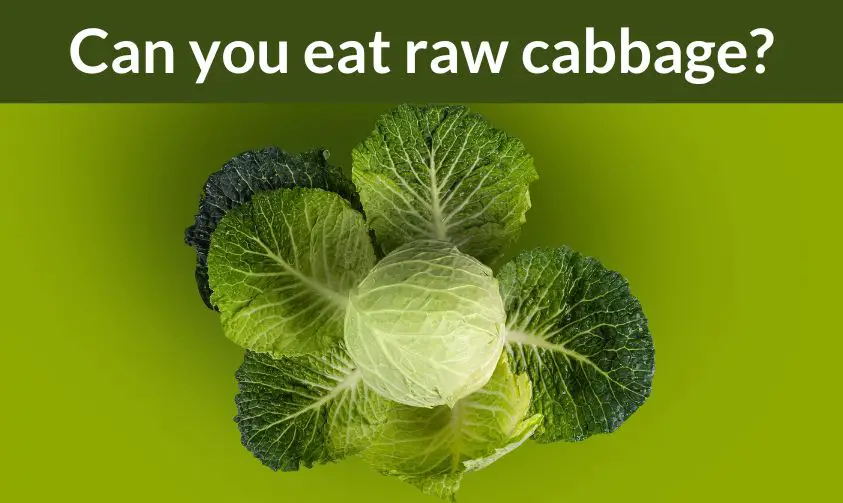Raw cabbage is a versatile and nutrient-rich vegetable that has been a staple in diets across the world for centuries. However, many people are still unsure about whether or not it’s safe to eat raw.
If you’ve ever found yourself wondering “can you eat raw cabbage?”, you’re not alone. In fact, it’s a common question that often stems from concerns about potential health risks or a lack of familiarity with this leafy green.
In this article, we’ll explore the nutritional benefits of raw cabbage, discuss the risks and precautions associated with consuming it, and provide various preparation techniques and recipe ideas to help you incorporate it into your diet safely and deliciously.
We’ll also delve into the cultural significance of raw cabbage in different cuisines and compare its nutritional value to other cruciferous vegetables.
By the end of this article, you’ll have all the information you need to confidently add raw cabbage to your meals.
Whether you’re a seasoned cabbage enthusiast or a curious newbie, this article has something for you. So let’s dive into the world of raw cabbage and discover all the amazing benefits this vegetable has to offer.

Nutritional Benefits of Raw Cabbage
Raw cabbage is a nutrient powerhouse, packed with vitamins, minerals, and antioxidants that can benefit your health in numerous ways. Here are some of the key nutrients found in raw cabbage:
Vitamins:
- Vitamin C – Raw cabbage is a great source of vitamin C, with just one cup providing over 50% of your daily recommended intake. Vitamin C is a powerful antioxidant that helps boost your immune system and promote healthy skin, among other benefits.
- Vitamin K – Raw cabbage is also high in vitamin K, a nutrient that plays a crucial role in blood clotting and bone health.
Minerals:
- Potassium – Raw cabbage contains potassium, an essential mineral that helps regulate fluid balance, maintain healthy blood pressure, and support proper muscle and nerve function.
- Calcium – While not as high in calcium as some other leafy greens, raw cabbage still contains this important mineral, which is essential for strong bones and teeth.
Antioxidants:
- Anthocyanins – Raw red cabbage is particularly rich in anthocyanins, a type of antioxidant that gives it its vibrant purple color. Studies have shown that anthocyanins may help reduce inflammation, promote heart health, and protect against certain types of cancer.
- Sulforaphane – Raw cabbage also contains sulforaphane, a powerful antioxidant that has been linked to numerous health benefits, including a reduced risk of cancer and improved heart health.
Risks and Precautions of Eating Raw Cabbage
While raw cabbage can provide numerous health benefits, there are some risks and precautions associated with consuming it. Here are some important factors to keep in mind:
Digestive Issues:
- Gas and Bloating – Raw cabbage is high in fiber and complex carbohydrates, which can be difficult for some people to digest. This can lead to gas and bloating, especially for those with digestive issues such as irritable bowel syndrome (IBS).
- Goitrogens – Raw cabbage also contains goitrogens, compounds that can interfere with thyroid function in some people. While cooking cabbage can reduce goitrogen content, raw cabbage should be consumed in moderation by individuals with thyroid issues.
Foodborne Illness:
- Bacteria – Raw cabbage can be contaminated with bacteria such as E. coli and salmonella, which can cause foodborne illness. It’s important to wash raw cabbage thoroughly before consuming it to reduce the risk of contamination.
- Cross-Contamination – Raw cabbage can also become contaminated through cross-contamination with other foods, such as raw meat. To avoid this, always wash cutting boards and utensils thoroughly after use and keep raw cabbage away from other raw meats and seafood.
Allergic Reactions:
- Pollen-Food Allergy Syndrome – Some individuals may experience allergic reactions to raw cabbage due to pollen-food allergy syndrome. This occurs when the immune system mistakes certain proteins in raw cabbage for pollen allergens, causing an allergic reaction.
By keeping these risks and precautions in mind, you can safely enjoy the nutritional benefits of raw cabbage without experiencing any negative side effects.
Preparation Techniques for Raw Cabbage
Raw cabbage can be prepared in a variety of ways to suit your taste preferences. Here are some techniques to try:
- Shredding – Shred raw cabbage finely for use in salads or slaws.
- Chopping – Chop raw cabbage into bite-sized pieces for stir-fries or roasted vegetable dishes.
- Fermenting – Fermenting raw cabbage with salt and other seasonings can create a tangy and flavorful sauerkraut that’s packed with probiotics.
- Pickling – Pickling raw cabbage with vinegar and spices can create a tangy and crunchy side dish that pairs well with sandwiches or grilled meats.
By experimenting with different preparation techniques, you can find new and delicious ways to enjoy raw cabbage in your meals.
In the next section, we’ll explore some of the delicious ways to incorporate raw cabbage into your diet.
Delicious Ways to Incorporate Raw Cabbage into Your Diet
If you’re looking to add more raw cabbage into your diet, there are a variety of delicious ways to do so. Here are some creative ideas to get you started:
Salads:
- Coleslaw – Coleslaw is a classic dish that features raw cabbage, carrots, and a creamy dressing. Try making your own coleslaw at home with a healthy dressing made from Greek yogurt and mustard.
- Asian-Inspired Salad – Mix shredded raw cabbage with shredded carrots, chopped scallions, and a soy-ginger dressing for a refreshing and flavorful salad.
Wraps:
- Cabbage Wraps – Use large cabbage leaves as a wrap for your favorite protein, such as chicken or tofu. Add some shredded carrots and a peanut sauce for a delicious and healthy meal.
- Lettuce Wraps – Use raw cabbage leaves as a substitute for lettuce in your favorite lettuce wrap recipe. The slightly sweet and crunchy texture of the cabbage pairs well with savory fillings like ground turkey and chopped vegetables.
Smoothies:
- Green Smoothie – Add some raw cabbage to your next green smoothie for an extra boost of nutrition. The mild flavor of cabbage pairs well with ingredients like spinach, banana, and almond milk.
- Fruit Smoothie – Mix shredded raw cabbage with frozen berries, almond milk, and honey for a sweet and satisfying smoothie that’s packed with vitamins and minerals.
Cultural Significance of Raw Cabbage
Raw cabbage has a rich cultural significance in many cuisines around the world. In some cultures, it’s considered a staple ingredient that’s used in a variety of traditional dishes. For example:
- Korean Cuisine – Kimchi is a traditional Korean dish made from fermented cabbage that’s spiced with chili powder, garlic, and other seasonings. It’s often served as a side dish or used as a condiment in other dishes.
- German Cuisine – Sauerkraut is a classic German dish made from fermented cabbage that’s often served as a side dish with sausages or roasted meats.
- Polish Cuisine – Bigos is a traditional Polish stew that features raw cabbage, sauerkraut, and various meats and vegetables.
By learning about the cultural significance of raw cabbage, you can gain a deeper appreciation for its history and culinary uses.
Nutritional Comparisons to Other Cruciferous Vegetables
Raw cabbage is just one member of the cruciferous vegetable family, which also includes broccoli, cauliflower, and kale. Here’s how raw cabbage compares nutritionally to some of its cruciferous cousins:
- Broccoli – Raw broccoli has similar amounts of vitamin C and fiber as raw cabbage, but is slightly higher in vitamin K and potassium.
- Cauliflower – Raw cauliflower has slightly fewer calories and carbohydrates than raw cabbage, but is higher in vitamin C and potassium.
- Kale – Raw kale is higher in many vitamins and minerals than raw cabbage, including vitamin A, vitamin K, calcium, and iron.
While all of these cruciferous vegetables are nutritious and beneficial for health, raw cabbage has its own unique set of nutritional benefits that make it a valuable addition to a healthy and balanced diet..
In the final section, we’ll summarize the main points of the article and provide some key takeaways.
Conclusion: Should You Eat Raw Cabbage?
Raw cabbage is a nutritious and versatile vegetable that can provide a variety of health benefits. From promoting digestion to reducing inflammation, incorporating raw cabbage into your diet can have a positive impact on your overall health and well-being.
However, it’s important to keep in mind the potential risks and precautions associated with consuming raw cabbage, such as digestive issues, foodborne illness, and allergic reactions. By following proper food safety measures and consuming raw cabbage in moderation, you can safely enjoy all of its nutritional benefits.
To sum up, raw cabbage can be a delicious and healthy addition to your diet when prepared and consumed properly. Whether you choose to enjoy it in salads, wraps, or smoothies, there are plenty of creative and flavorful ways to incorporate this nutritious vegetable into your meals.
Remember to consult with a healthcare professional if you have any concerns about consuming raw cabbage or any other dietary questions. By making informed choices and enjoying a varied and balanced diet, you can optimize your health and well-being for years to come.


